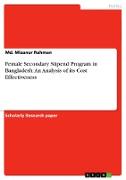- Start
- Female Secondary Stipend Program in Bangladesh: An Analysis of its Cost Effectiveness
Female Secondary Stipend Program in Bangladesh: An Analysis of its Cost Effectiveness
Angebote / Angebote:
Research paper from the year 2013 in the subject Politics - International Politics - Region: Other States, , language: English, abstract: Bangladesh as one of the South Asian countries has been striving to develop a comprehensive
education policy since its independence but failed to formulate such policy that could contribute to the
development of the economy. The basic problem of primary and secondary level is poor enrolment
and low retention rate in the school. To combat with this problem government of Bangladesh has been
undertaking myriad policies and programs. Among such policies Female Secondary Stipend Program
(FSSP), Food For Education Program (FFEP) and Free Text Book Distribution Program to the
students of primary and secondary level are some innovative and better contributing policy
interventions in the field of female education in Bangladesh. All these policy interventions are
purported with the pivotal motto of reducing drop rate and increasing enrollment rate in the secondary
education. All these policies are currently in operation except the Food for Education Program which
has transformed into a cash transfer program very recently. Based on the policy problem of reducing
dropout rate of the secondary female students in the school, the above policies on FFEP, FTBDP and
FSSP were chosen as three policy alternatives taking FSSP as status quo with a view to measuring
efficacy of these policies employing the cost effectiveness analysis method apprising their relative
worth in reducing dropout of female students in the secondary level calculating the base year 1994 and
analyzing up to 2015 years data and thereafter to suggest the best policy option for the government of
Bangladesh. Data were generated and gathered from the available literatures on the above-mentioned
alternatives. Primarily FSSP populations were used as baseline population and compare it with
dropout and enrolment rate achieved of all the
Folgt in ca. 10 Arbeitstagen
